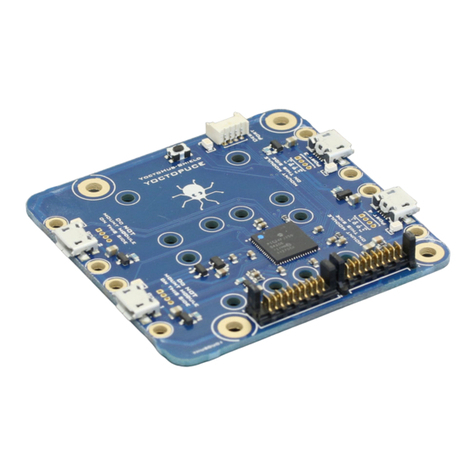2. Presentation
2.2. Activity Led
The activity led will shine when devices are detected on any down port. If no device is present, then
the activity led will stay off and the hub will go to sleep mode to spare power.
2.3. USB power distribution
Although USB means Universal Serial BUS, USB devices are not physically organized as a flat bus
but as a tree, using point-to-point connections. This has consequences on power distribution: to
make it simple, every USB port must supply power to all devices directly or indirectly connected to it.
And USB puts some limits.
In theory, a USB port provides 100mA, and may provide up to 500mA if available and requested by
the device. In the case of a hub without external power supply, 100mA are available for the hub itself,
and the hub should distribute no more than 100mA to each of its ports. This is it, and this is not
much. In particular, it means that in theory, it is not possible to connect USB devices through two
cascaded hubs without external power supply. In order to cascade hubs, it is necessary to use self-
powered USB hubs, that provide a full 500mA to each subport.
In practice, USB would not have been as successful if it was really so picky about power distribution.
As it happens, most USB hub manufacturers have been doing savings by not implementing current
limitation on ports: they simply connect the computer power supply to every port, and declare
themselves as self-powered hub even when they are taking all their power from the USB bus (in
order to prevent any power consumption check in the operating system). This looks a bit dirty, but
given the fact that computer USB ports are usually well protected by a hardware current limitation
around 2000mA, it actually works in every day life, and seldom makes hardware damage.
What you should remember: if you connect Yoctopuce modules through one, or more, USB hub
without external power supply, you have no safe-guard and you depend entirely on your computer
manufacturer attention to provide as much current as possible on the USB ports, and to detect
overloads before they lead to problems or to hardware damages. When modules are not provided
enough current, they may work erratically and create unpredictable bugs. If you want to prevent any
risk, do not cascade hubs without external power supply, and do not connect peripherals requiring
more than 100mA behind a bus-powered hub.
In order to help you controlling and planning overall power consumption for your project, all
Yoctopuce modules include a built-in current sensor that indicates (with 5mA precision) the
consumption of the module on the USB bus.
Note also that the USB cable itself may also cause power supply issues, in particular when the wires
are too thin or when the cable is too long 1. Good cables are usually made using AWG 26 or AWG 28
wires for data lines and AWG 24 wires for power.
2.4. Electromagnetic compatibility (EMI)
Connection methods to integrate the Micro-USB-Hub-V2 obviously have an impact on the system
overall electromagnetic emissions, and therefore also impact the conformity with international
standards.
When we perform reference measurements to validate the conformity of our products with IEC
CISPR 11, we do not use any enclosure but connect the devices using a shielded USB cable,
compliant with USB 2.0 specifications: the cable shield is connected to both connector shells, and the
total resistance from shell to shell is under 0.6Ω. The USB cable length is 3m, in order to expose one
meter horizontally, one meter vertically and keep the last meter close to the host computer within a
ferrite bead.
1 www.yoctopuce.com/EN/article/usb-cables-size-matters




























